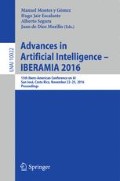Abstract
The vast amount of electronic documents available on the Internet demands for automatic tools that help people finding, organizing and easily accessing to all this information. Although current text classification methods have alleviated some of the above problems, such strategies depend on having a large and reliable set of labeled data. In order to overcome such limitation, this work proposes an alternative approach for semi-supervised text classification, which is based on a new strategy for diminishing the sensitivity to the noise contained on labeled data by means of automatic text summarization. Experimental results showed that our proposed approach outperforms traditional semi-supervised text classification techniques; additionally, our results also indicate that our approach is suitable for learning from only one labeled example per category.
Access this chapter
Tax calculation will be finalised at checkout
Purchases are for personal use only
Notes
- 1.
Normally the direction of the edges is determined by the order of the sentences in the original document.
- 2.
The parameter that defines the length of a summary is also known as the compression rate parameter, and represents a number that indicates the percentage of the information that we are requiring to preserve from the original document.
- 3.
One disadvantage of self-training is that mistakes reinforce/strengthen themselves; it is well known that accuracies lower than random at the beginning tend to conduct to worst results in subsequent iterations.
- 4.
References
Sebastiani, F.: Machine learning in automated text categorization. ACM Comput. Surv. (CSUR) 34(1), 1–47 (2002)
Villuendas-Rey, Y., Garcia-Lorenzo, M.M.: Attribute and case selection for nn classifier through rough sets and naturally inspired algorithms. Computación y Sistemas 18(2), 295–311 (2014)
Fusilier, D.H., Montes-y-Gómez, M., Rosso, P., Cabrera, R.G.: Detecting positive and negative deceptive opinions using PU-learning. Inf. Process. Manag. 51(4), 433–443 (2015)
López-Monroy, A.P., Montes-y-Gómez, M., Escalante, H.J., Villaseñor-Pineda, L., Stamatatos, E.: Discriminative subprofile-specific representations for author profiling in social media. Knowl.-Based Syst. 89, 134–147 (2015)
Solorio, T.: Using unlabeled data to improve classifier accuracy. M. Sc. Degree thesis, Computer Science Department, Inaoe, Mexico (2002)
Guzmán-Cabrera, R., Montes-y-Gómez, M., Rosso, P., Villaseñor-Pineda, L.: Using the web as corpus for self-training text categorization. Inf. Retrieval 12(3), 400–415 (2009)
Zheng, Y., Teng, S., Liu, Z., Sun, M.: Text classification based on transfer learning and self-training. In: 2008 Fourth International Conference on Natural Computation, vol. 3, pp. 363–367, October 2008
Gao, W., Li, S., Xue, Y., Wang, M., Zhou, G.: Semi-supervised sentiment classification with self-training on feature subspaces. In: Su, X., He, T. (eds.) CLSW 2014. LNCS, vol. 8922, pp. 231–239. Springer, Heidelberg (2014)
Mihalcea, R., Hassan, S.: Using the essence of texts to improve document classification. In: Proceedings of the Recent Advances in Natural Language Processing (RANLP-2005) (2005)
Anguiano-Hernández, E., Villaseñor-Pineda, L., Montes-y-Gómez, M., Rosso, P.: Summarization as feature selection for document categorization on small datasets. In: Loftsson, H., Rögnvaldsson, E., Helgadóttir, S. (eds.) IceTAL 2010. LNCS, vol. 6233, pp. 39–44. Springer, Heidelberg (2010)
Fei-Fei, L., Fergus, R., Perona, P.: One-shot learning of object categories. IEEE Trans. Pattern Anal. Mach. Intell. 28, 594–611 (2006)
Ker, S.J., Chen, J.-N.: A text categorization based on summarization technique. In: Proceedings of the ACL-2000 Workshop on Recent Advances in Natural Language Processing and Information Retrieval: Held in Conjunction with the 38th Annual Meeting of the Association for Computational Linguistics, vol. 11, pp. 79–83. Association for Computational Linguistics (2000)
Ko, Y., Park, J., Seo, J.: Automatic text categorization using the importance of sentences. In: Proceedings of the 19th International Conference on Computational linguistics, vol. 1, pp. 1–7. Association for Computational Linguistics (2002)
Xiao-Yu, J., Xiao-Zhong, F., Zhi-Fei, W., Ke-Liang, J.: Improving the performance of text categorization using automatic summarization. In: International Conference on Computer Modeling and Simulation, ICCMS 2009, pp. 347–351. IEEE (2009)
Kolcz, A., Prabakarmurthi, V., Kalita, J.: Summarization as feature selection for text categorization. In: Proceedings of the Tenth International Conference on Information and Knowledge Management, pp. 365–370. ACM (2001)
Kleinberg, J.M.: Authoritative sources in a hyperlinked environment. J. ACM (JACM) 46(5), 604–632 (1999)
Cachopo, A.M.D.J.C.: Improving methods for single-label text categorization. Ph.D. thesis, Universidade Técnica de Lisboa (2007)
Litvak, M., Vanetik, N.: Multi-document summarization using tensor decomposition. Computación y Sistemas 18(3), 581–589 (2014)
Acknowledgments
This work was partially funded by CONACyT, project number 247870 and 258588. We appreciate the support provided by the Thematic Networks program (Language Technologies Thematic Network projects 260178 and 271622). We thank to UAM Cuajimalpa and SNI for their support.
Author information
Authors and Affiliations
Corresponding author
Editor information
Editors and Affiliations
Rights and permissions
Copyright information
© 2016 Springer International Publishing AG
About this paper
Cite this paper
Villatoro-Tello, E., Anguiano, E., Montes-y-Gómez, M., Villaseñor-Pineda, L., Ramírez-de-la-Rosa, G. (2016). Enhancing Semi-supevised Text Classification Using Document Summaries. In: Montes y Gómez, M., Escalante, H., Segura, A., Murillo, J. (eds) Advances in Artificial Intelligence - IBERAMIA 2016. IBERAMIA 2016. Lecture Notes in Computer Science(), vol 10022. Springer, Cham. https://doi.org/10.1007/978-3-319-47955-2_10
Download citation
DOI: https://doi.org/10.1007/978-3-319-47955-2_10
Published:
Publisher Name: Springer, Cham
Print ISBN: 978-3-319-47954-5
Online ISBN: 978-3-319-47955-2
eBook Packages: Computer ScienceComputer Science (R0)

